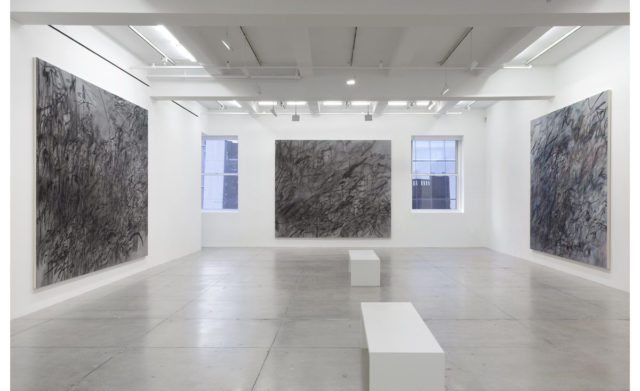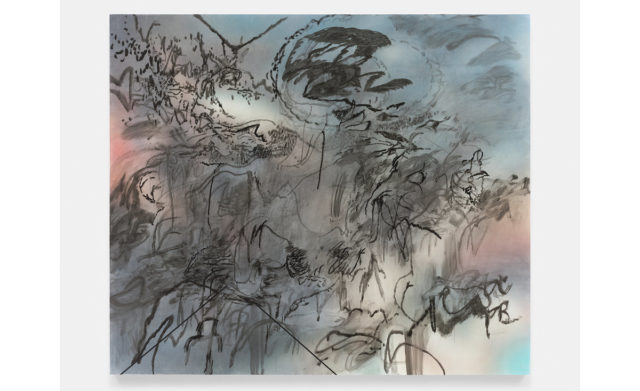
Julie Mehretu, Installation view, 2016 Marian Goodman
How valuable are first impressions? In art, this seems to be a perennially important question. A work should, aesthetically, stand on its own. Except, of course, when it doesn’t matter because the concept determines the formal choices. Or when aesthetics kinda sorta matter but so does the context.
It’s this latter murky territory where we’ve been seeing a lot of artistic activity. From Gerhard Richter’s holocaust paintings (the Birkenau series) to activist Theaster Gates’s fire hoses and floor board sculptures, artists pairing abstraction with politics and world events now dot the gallery circuit. The going name for it, “Social Abstraction” (coined by Mark Bradford), describes a politically conscious subset of artists who use art as a vehicle to express their investment in varying concerns.
I’m all for this approach to art making—we live in a tumultuous time and artists can not afford to be politically detached—but the results thus far seem fairly conservative. The work of both Richter and Gates relies heavily on the 20th century cannon of art, but the most recent example comes from Julie Mehretu’s current exhibition at Marian Goodman. Open through October 29, her latest paintings draw from media images of the Syrian civil war and Ferguson and reveal the pitfalls of using abstraction as a means of addressing political issues.
At first glance, the show looks like what would happen if you turned off the color in a series of abstract expressionist paintings. It’s Cy Twombly with an airbrush. It’s Albert Oehlen in greyscale. It’s indoor graffiti. There’s not much new going on here.

Julie Mehretu, Conjured Parts, (head), 2016, ink and acrylic on canvas
There is, however, considerable skill brought to the work. Roughly five over sized paintings hang in each gallery, each exhibiting a deft layering a scumbled, Guston-like style of mark-making, over airbrushed surfaces in bluish grey tones. Slight undulations of pink and blue push forward in paintings such as “Conjured Parts (Head), Aleppo”, and “Stelae 3 (Bardu)” read as if light were pushing through the painting.
Without the titles, there’s no way to identify the grim events that inspire the work. The paintings add little to a path of abstract artist well trodden by now. With them, the mass of gestural marks look like rubble and the bits of color and light, a flicker of hope. It’s a bit too obvious.
This back and forth doesn’t work out that well for Mehretu, and after contemplating the work for a while, I wondered if my assessment might be unduly harsh. By virtue of the discipline, abstract artists have limited means express their concerns about politics, world events or anything else. Is the bar for achievement too high for most artists to reach?(Mark Bradford not withstanding.) Is Mehretu’s show transitional and thus requires more time to develop?
I don’t have the answers to these questions, which leaves me circling back to my first impressions. They weren’t positive, and while the work has certainly grown through the review process, I’m still not convinced. I wanted more from these paintings than Mehretu had to give, and there’s no amount of wordsmithing that’s going to change that.


Comments on this entry are closed.